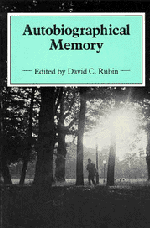Book contents
- Frontmatter
- Contents
- List of contributors
- Preface
- Part I Overview
- Part II Historical, theoretical, and methodological contexts for the study of autobiographical memory
- 2 Autobiographical memory: a historical prologue
- 3 What is autobiographical memory?
- 4 Ways of searching and the contents of memory
- Part III The general organization of autobiographical memory
- Part IV The temporal organization of autobiographical memory
- Part V Temporal distributions of autobiographical memories
- Part VI Failures of autobiographical memory
- Author index
- Subject index
4 - Ways of searching and the contents of memory
Published online by Cambridge University Press: 01 March 2011
- Frontmatter
- Contents
- List of contributors
- Preface
- Part I Overview
- Part II Historical, theoretical, and methodological contexts for the study of autobiographical memory
- 2 Autobiographical memory: a historical prologue
- 3 What is autobiographical memory?
- 4 Ways of searching and the contents of memory
- Part III The general organization of autobiographical memory
- Part IV The temporal organization of autobiographical memory
- Part V Temporal distributions of autobiographical memories
- Part VI Failures of autobiographical memory
- Author index
- Subject index
Summary
What do we know about the contents of human memory? A preliminary listing might be obtained by surveying the literature. Such a review shows, however, that we know precious little about the denizens of that natural habitat, the mind. It quickly becomes clear that in such a quest we cannot inquire about contents generally – the question must be narrowed. An image that helps to focus my ideas is the following.
I see myself as an ethologist or a population biologist. I might be Darwin arriving at the Galapagos Islands. It is not idle for a biologist/botanist freshly come to a new shore to ask what organisms live in the new environment. What organisms make permanent homes here? Which are migratory, coming and going throughout the seasons? Which use the land during the day, which during the night? How large are the populations now? Which beasts thrive? Which will be here tomorrow, and which in a hundred tomorrows? The census of the Galapagos, like the census of New York, yields data obtainable from no other source, giving us hints about how life in a complex system works and providing a basis for understanding other relationships in the world. A census of the contents of the mind might give us, as the census does for biology, some sense of the fitness of ideas for survival and the shapes that items assume before reaching stable configurations.
Information
- Type
- Chapter
- Information
- Autobiographical Memory , pp. 50 - 68Publisher: Cambridge University PressPrint publication year: 1986
Accessibility standard: Unknown
- 113
- Cited by
